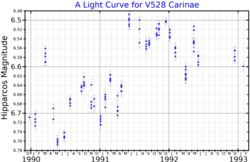Astronomy:V528 Carinae
| Observation data Equinox J2000.0]] (ICRS) | |
|---|---|
| Constellation | Carina |
| Right ascension | 11h 03m 06.15s[1] |
| Declination | 60° 54′ 38.6″[1] |
| Apparent magnitude (V) | 6.27 - 6.78[2] |
| Characteristics | |
| Spectral type | M2 Ib:[3][4] |
| B−V color index | +2.04[5] |
| Variable type | Lc[6] |
| Astrometry | |
| Radial velocity (Rv) | −27.80[7] km/s |
| Proper motion (μ) | RA: –7.639[1] mas/yr Dec.: +2.109[1] mas/yr |
| Parallax (π) | 0.4504 ± 0.0293[1] mas |
| Distance | 7,200 ± 500 ly (2,200 ± 100 pc) |
| Details | |
| Radius | 415[8] R☉ |
| Luminosity | 26,000 - 28,000[8] L☉ |
| Surface gravity (log g) | 0.0[5] cgs |
| Temperature | 3,660±170[8] K |
| Other designations | |
| Database references | |
| SIMBAD | data |
V528 Carinae (V528 Car, HD 95950, HIP 54021) is a variable star in the constellation Carina.
V528 Carinae has an apparent visual magnitude that varies between about 6.3 and 6.8. It is a distant star but the exact distance is uncertain. The Hipparcos satellite gives a negative annual parallax and is not helpful,[9] while the Gaia Data Release 3 parallax of 0.45 mas implies a distance around 7,200 light years.[1] Assuming membership of the Carina OB2 membership would give a distance of about 1,830 parsecs.[10]
V528 Carinae is a red supergiant of spectral type M2 Ib with an effective temperature of 3,660 K. It has a radius of 415 solar radii. In the visible spectrum, its luminosity is 11,900 times higher than the sun, but the bolometric luminosity considering all wavelengths reaches around 30,000 L☉.[8] It loses mass at 0.5×10−9 M☉ per year.[12]
It is classified as a slow irregular variable whose prototype is TZ Cassiopeiae.[6]
See also
References
- ↑ 1.0 1.1 1.2 1.3 1.4 1.5 Vallenari, A. et al. (2022). "Gaia Data Release 3. Summary of the content and survey properties". Astronomy & Astrophysics. doi:10.1051/0004-6361/202243940 Gaia DR3 record for this source at VizieR.
- ↑ "V528 Car". AAVSO. https://www.aavso.org/vsx/index.php?view=detail.top&oid=6281.
- ↑ Humphreys, Roberta M.; Strecker, Donald W.; Ney, E. P. (1972). "Spectroscopic and Photometric Observations of M Supergiants in Carina". Astrophysical Journal 172: 75. doi:10.1086/151329. Bibcode: 1972ApJ...172...75H.
- ↑ Malyuto, V.; Oestreicher, M. O.; Schmidt-Kaler, Th. (1997). "Quantitative spectral classification of galactic disc K-M stars from spectrophotometric measurements". Monthly Notices of the Royal Astronomical Society 286 (2): 500. doi:10.1093/mnras/286.2.500. Bibcode: 1997MNRAS.286..500M.
- ↑ 5.0 5.1 Cite error: Invalid
<ref>tag; no text was provided for refs namedrg - ↑ 6.0 6.1 Samus, N. N. et al. (2009). "VizieR Online Data Catalog: General Catalogue of Variable Stars (Samus+ 2007-2013)". VizieR On-line Data Catalog: B/GCVS. Originally Published in: 2009yCat....102025S 1. Bibcode: 2009yCat....102025S.
- ↑ Gontcharov, G. A. (2006). "Pulkovo Compilation of Radial Velocities for 35 495 Hipparcos stars in a common system". Astronomy Letters 32 (11): 759–771. doi:10.1134/S1063773706110065. Bibcode: 2006AstL...32..759G.
- ↑ 8.0 8.1 8.2 8.3 Messineo, M.; Brown, A. G. A. (2019). "A Catalog of Known Galactic K-M Stars of Class I Candidate Red Supergiants in Gaia DR2". The Astronomical Journal 158 (1): 20. doi:10.3847/1538-3881/ab1cbd. Bibcode: 2019AJ....158...20M.
- ↑ Van Leeuwen, F. (2007). "Validation of the new Hipparcos reduction". Astronomy and Astrophysics 474 (2): 653–664. doi:10.1051/0004-6361:20078357. Bibcode: 2007A&A...474..653V.
- ↑ Melnik, A. M.; Dambis, A. K. (2020). "Distance scale for high-luminosity stars in OB associations and in field with Gaia DR2. Spurious systematic motions". Astrophysics and Space Science 365 (7): 112. doi:10.1007/s10509-020-03827-0. Bibcode: 2020Ap&SS.365..112M.
- ↑ "/ftp/cats/more/HIP/cdroms/cats". Strasbourg astronomical Data Center. https://cdsarc.cds.unistra.fr/viz-bin/ftp-index?/ftp/cats/more/HIP/cdroms/cats.
- ↑ Josselin, E.; Blommaert, J. A. D. L.; Groenewegen, M. A. T.; Omont, A.; Li, F. L. (2000). "Observational investigation of mass loss of M supergiants". Astronomy and Astrophysics 357: 225. Bibcode: 2000A&A...357..225J.
 |


